Related Research Articles

Atlantic County is a county located along the southern coast of the U.S. state of New Jersey. As of the 2020 U.S. census, the county had a population of 274,534. Its county seat is the Mays Landing section of Hamilton Township. Geographically, the county is part of the South Jersey region.

Egg Harbor Township is a township in Atlantic County, in the U.S. state of New Jersey. The U.S. Census Bureau in the 2020 census reported the population as 47,842, an increase of 4,519 over the 43,323 counted in the previous decade in the 2010 census.
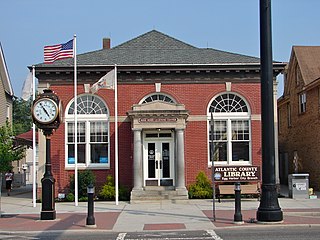
Egg Harbor City is a city in Atlantic County, New Jersey, United States. As of the 2020 United States Census, the city's population was 4,396, an increase of 153 from the 2010 Census. As of the 2010 United States Census, the city's population was 4,243, reflecting a decline of 302 (−6.6%) from the 4,545 counted in the 2000 Census, which had in turn declined by 38 (−0.8%) from the 4,583 counted in the 1990 Census.
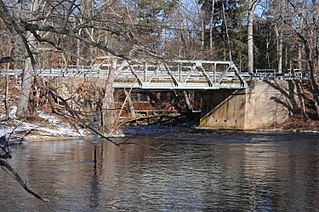
Hamilton Township is a township in Atlantic County, New Jersey. As of the 2010 U.S. census, the township's population was 26,503, reflecting an increase of 6,004 (+29.3%) from the 20,499 counted in the 2000 census, which had in turn increased by 4,487 (+28.0%) from the 16,012 counted in the 1990 census. The Township of Hamilton was incorporated by the New Jersey Legislature on February 5, 1813.

The Great Egg Harbor River is a 55.0-mile-long (88.5 km) river in South Jersey. It is one of the major rivers that traverse the largely pristine Pinelands, draining 308 square miles (800 km2) of wetlands into the Atlantic Ocean at Great Egg Harbor, from which it takes its name.

Effie M. Morrissey is a schooner skippered by Robert Bartlett that made many scientific expeditions to the Arctic, sponsored by American museums, the Explorers Club and the National Geographic Society. She also helped survey the Arctic for the United States Government during World War II. She is currently designated by the United States Department of the Interior as a National Historic Landmark as part of the New Bedford Whaling National Historical Park. She is the State Ship of Massachusetts.

USS LST-325 is a decommissioned tank landing ship of the United States Navy, now docked in Evansville, Indiana, US. Like many of her class, she was not named and is properly referred to by her hull designation.

A.J. Meerwald, later known as Clyde A. Phillips, is a restored dredging oyster schooner, whose home port is in the Bivalve section of Commercial Township in Cumberland County, New Jersey. The schooner was added to the National Register of Historic Places on November 7, 1995 for her significance in architecture, commerce, and maritime history. She became the state tall ship in 1998. Today, A.J. Meerwald is used by the Bayshore Center at Bivalve for onboard educational programs in the Delaware Bay, and at other ports in the New Jersey, Pennsylvania, and Delaware region.

Governor Stone is a historic schooner, built in 1877, in Pascagoula, Mississippi. She is the only surviving two-masted coasting cargo schooner built on the Gulf Coast of the United States, and is only one of five such surviving US-built ships. On 4 December 1991, she was added to the US National Register of Historic Places. One year later, the schooner was designated a US National Historic Landmark. She is presently berthed at Saint Andrews Marina in Panama City, Florida, where she is maintained by a nonprofit group. Sailing tours are regularly scheduled.

The schooner Bowdoin was designed by William H. Hand, Jr., and built in 1921, in East Boothbay, Maine, at the Hodgdon Brothers Shipyard now known as Hodgdon Yachts. She is the only American schooner built specifically for Arctic exploration, and was designed under the direction of explorer Donald B. MacMillan. She has made 29 trips above the Arctic Circle in her life, three since she was acquired by the Maine Maritime Academy in 1988. She is currently owned by the Maine Maritime Academy, located in Castine, Maine, and is used for their sail training curriculum. She is named for Bowdoin College.

The schooner J. & E. Riggin, a National Historic Landmark, was built on the Maurice River in Dorchester, New Jersey in 1927. She is one of a small number of surviving two-masted schooners, once one of the most common sailing ships in North American waters. Now based in Rockland, Maine, she serves as a "windjammer" offering sailing cruises to tourists.

Adventure is a gaff rigged knockabout schooner. She was built in Essex, Massachusetts, USA, and launched in 1926 to work the Grand Banks fishing grounds out of Gloucester. She is one of only two surviving knockabout fishing schooners – ships designed without bowsprits for the safety of her crew.
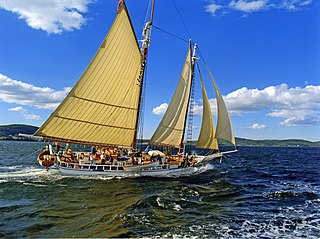
Isaac H. Evans, originally Boyd N. Sheppard, is a two-masted schooner berthed in Rockland, Maine. She is a Maine windjammer, serving the tourist trade. Built in 1886 in Mauricetown, New Jersey, she is the oldest of a small number of surviving oyster schooners, used in service of the oyster harvesting industry in the coastal waters of New Jersey. She was declared a National Historic Landmark in 1992.
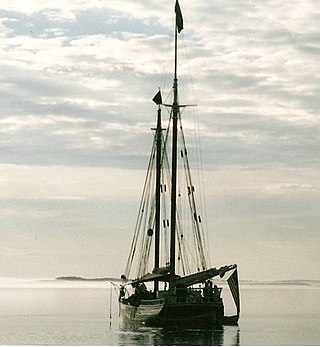
Stephen Taber is a two-masted schooner, built in 1871, operating as a "windjammer" in the tourist trade out of Rockland, Maine. A National Historic Landmark, she is one of a small number of surviving schooners originally built for the Atlantic coasting trade, and one of only three with a centerboard, allowing access through shallow channels and to shallow landing points. She is named for New York lawyer and politician Stephen Taber, and has a well-documented history of continuous service since her construction.

Capt. John Jeffries Burial Marker is an historic burial monument in the cemetery at Scullville Bible Church in Egg Harbor Township, New Jersey, along County Route 559 near Somers Point. It was built in 1887 and added to both the New Jersey Register of Historic Places and the National Register of Historic Places in 1984.

The Shearwater is an 81.5-foot (24.8 m) wooden schooner docked in Lower Manhattan in New York City in the U.S. state of New York. The schooner was designed by Theodore Donald Wells and built by the Rice Brothers Corporation in East Boothbay, Maine in 1929. During World War II, it was requisitioned into the United States Coast Guard to patrol for German U-boats. The Shearwater completed a circumnavigation of the world in the early-1980s and later worked as a research laboratory for the University of Pennsylvania's Institute of Environmental Medicine. Docked about 200 yards (180 m) west of the site of the World Trade Center, it is operated by Manhattan by Sail, which gives 90-minute-long tours of New York Harbor, and is licensed to carry 48 passengers. The schooner was listed on the National Register of Historic Places in 2009.

Green Bank is an unincorporated community located within Washington Township, in Burlington County, New Jersey, United States. It is located on the Mullica River.

SS Robert Wallace was a wooden-hulled American bulk freighter that served on the Great Lakes of North America from her construction in 1882 to her sinking in 1902 on Lake Superior near the town of Palmers, St. Louis County, Minnesota, United States. On November 17, 1902 shortly after leaving Superior, Wisconsin with a cargo of iron ore, Robert Wallace sprang a leak and sank. Her wreck was found in 2006, and on October 14, 2009, the wreck of Robert Wallace was listed in the National Register of Historic Places.

The George Spencer was a wooden lake freighter that sank on along with her schooner barge Amboy on Lake Superior, near Thomasville, Cook County, Minnesota in the Mataafa Storm of 1905. On April 14, 1994, the wrecks of the Spencer and the Amboy were listed on the National Register of Historic Places.
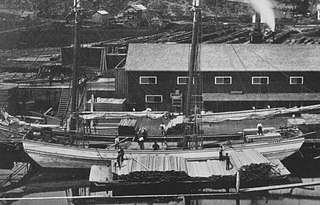
The Mayflower was a wooden hulled scow-schooner that sank on June 2, 1891, in Lake Superior near Duluth, Minnesota, United States, after capsizing with a load of sandstone blocks. In 2012 the shipwreck site was added to the National Register of Historic Places.
References
- 1 2 "National Register Information System – (#85000874)". National Register of Historic Places . National Park Service. November 2, 2013.
- ↑ "New Jersey and National Registers of Historic Places - Atlantic County" (PDF). New Jersey Department of Environmental Protection - Historic Preservation Office. January 10, 2010. p. 12. Retrieved March 27, 2010.
- 1 2 3 McKelvey, Wallace (December 24, 2012) [last updated September 21, 2019]. "Historic shipwreck in Mays Landing draws little attention today". Press of Atlantic City . Archived from the original on October 9, 2021.